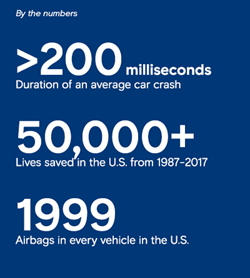Every millisecond matters in a car crash. Even the slightest malfunction or delay of a vehicle’s airbags can result in serious—even fatal—injuries.
Fortunately, airbags are designed to inflate rapidly through a highly controlled explosion. Manufacturers can use a boron compound—boron potassium nitrate (BKN)—to initiate this larger combustion reaction responsible for filling the airbag with nitrogen air.
Because it’s Operation Safe Driver Week, an educational initiative aimed at improving road and driver safety, we invite you to discover boron’s use in airbags and other car components.
The moment of impact
Airbags slow the driver’s forward motion evenly and prevent their head and body from colliding with the hard steering wheel. Airbags spread the impact’s force over a larger surface area and complement the role seatbelts play in protecting the driver and front seat passengers.
Before a car’s airbags are deployed, a sensor system detects the severity of a front-end crash. This system leverages multiple points to determine whether it’s necessary to activate an airbag. 
If the threshold is met, the sensor sends an electric signal to initiate a BKN powder mixture, also called an ignitor compound.
Igniter compounds must be reliable and work rapidly. BKN’s thermal stability makes it a suitable choice. Typically, boron comprises 25% of this compound, with potassium nitrate content at 75% by weight.
BKN ignites within two milliseconds, producing a high temperature that triggers another chemical reaction. This primary gas-generating reaction is responsible for filling the airbag.
For the main reaction, modern airbags typically use guanidinium nitrate and a copper nitrate oxidizer to produce the harmless nitrogen gas that fills the bag. This process typically happens within 20 to 30 milliseconds, faster than a human can blink.
Auto safety doesn’t stop with airbags
Boron is used in other car parts and systems to improve safety.
Brake reliability
In moisture-sensitive hydraulic brakes, boron prevents loss of brake power by lowering the boiling point of the fluid.
Engine protection
The antifreeze that regulates your car’s temperature also uses boron, ensuring the fluid has both a low freezing point and high boiling point. This keeps your engine running smoothly whether temperatures are extremely hot or cold.
Fire retardancy
Boron also helps safeguard against flammable polymer-based materials in a car. Borate compounds are used as flame retardant additives, preventing items such as cables, wires, and upholstery from igniting and burning.
Impact-resistant glass
Borosilicate glass can be used for windshields and headlights because it’s stronger and less likely to crack or shatter when struck by an object. Manufacturers also incorporate boron in the formation of thin, light touch screen displays in the car’s interior.
Stronger frames
Auto manufacturers incorporate borates into steel and aluminum-based alloys to strengthen a car’s frame. Borates remove impurities while also acting as a grain refiner, and hardening agent.
Read more: Borates in automobiles
Considering boron for your process?
For the automotive industry, manufacturing safer vehicles depends on sourcing high-quality materials, such as refined borates. Doing so reduces the risk of costly recalls and ensures drivers remain safe on the road.
If you have any questions about the borate products we offer, contact our technical team.
Resources